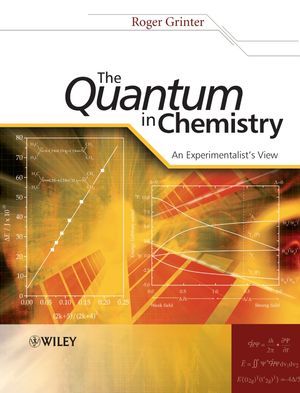The Quantum in Chemistry: An Experimentalist's ViewISBN: 978-0-470-01318-2
Paperback
480 pages
November 2005
 This is a Print-on-Demand title. It will be printed specifically to fill your order. Please allow an additional 10-15 days delivery time. The book is not returnable.
|
||||||
Chapter 1: The Role of Theory in the Physical Sciences.
1.0 Introduction.
1.1 What is the role of theory in science?
1.2 The gas laws of Boyle and Gay-Lussac.
1.3 An absolute zero of temperature.
1.4 The gas equation of Van der Waals.
1.5 Physical laws.
1.6 Laws, postulates, hypotheses, etc.
1.7 Theory at the end of the 19th century.
1.8 Bibliography and further reading.
Chapter 2: From Classical to Quantum Mechanics.
2.0 Introduction.
2.1 The motion of the planets: Tycho Brahe and Kepler.
2.2 Newton, Lagrange and Hamilton.
2.3 The power of classical mechanics.
2.4 The failure of classical physics.
2.5 The black-body radiator and Planck’s quantum hypothesis.
2.6 The photoelectric effect.
2.7 The emission spectra of atoms.
2.8 de Broglie’s proposal.
2.9 The Schrödinger equation.
2.10 Bibliography and further reading.
Chapter 3: The Application of Quantum Mechanics.
3.0 Introduction.
3.1 Observables, operators, eigenfunctions and eigenvalues.
3.2 The Schrödinger method.
3.3 An electron on a ring.
3.4 Hückel’s (4N + 2) rule: aromaticity.
3.5 Normalisation and orthogonality.
3.6 An electron in a linear box.
3.7 The linear and angular momenta of electrons confined within a one-dimensional box or on a ring.
3.8 The eigenfunctions of different operators.
3.9 Eigenfunctions, eigenvalues and experimental measurements.
3.10 More about measurement: the Heisenberg uncertainty principle.
3.11 The commutation of operators.
3.12 Combinations of eigenfunctions and the superposition of states.
3.13 Operators and their formulation.
3.14 Summary.
3.15 Bibliography and further reading.
Chapter 4: Angular Momentum.
4.0 Introduction.
4.1 Angular momentum in classical mechanics.
4.2 The conservation of angular momentum.
4.3 Angular momentum as a vector quantity.
4.4 Orbital angular momentum in quantum mechanics.
4.5 Spin angular momentum.
4.6 Total angular momentum.
4.7 Angular momentum operators and eigenfunctions.
4.8 Notation.
4.9 Some examples.
4.10 Bibliography and further reading.
Chapter 5: The Structure and Spectroscopy of the Atom.
5.0 Introduction.
5.1 The eigenvalues of the hydrogen atom.
5.2 The wave functions of the hydrogen atom.
5.3 Polar diagrams of the angular functions.
5.4 The complete orbital wave functions.
5.5 Other one-electron atoms.
5.6 Electron spin.
5.7 Atoms and ions with more than one electron.
5.8 The electronic states of the atom.
5.9 Spin-orbit coupling.
5.10 Selection rules in atomic spectroscopy.
5.11 The Zeeman effect.
5.12 Bibliography and further reading.
Chapter 6: The Covalent Chemical Bond.
6.0 Introduction.
6.1 The binding energy of the hydrogen molecule.
6.2 The Hamiltonian operator for the hydrogen molecule.
6.3 The Born–Oppenheimer approximation.
6.4 Heitler and London: The valence bond (VB) model.
6.5 Hund and Mulliken: the molecular orbital (MO) model.
6.6 Improving the wave functions.
6.7 Unification: Ionic structures and configuration interaction.
6.8 Electron correlation.
6.9 Bonding and antibonding Mos.
6.10 Why is there no He–He Bond?
6.11 Atomic orbital overlap.
6.12 The Homonuclear diatomic molecules from lithium to fluorine.
6.13 Heteronuclear diatomic molecules.
6.14 Charge distribution.
6.15 Hybridisation and resonance.
6.16 Resonance and the valence bond theory.
6.17 Molecular geometry.
6.18 Computational developments.
6.19 Bibliography and further reading.
Chapter 7: Bonding, Spectroscopy and Magnetism in Transition-Metal Complexes.
7.0 Introduction.
7.1 Historical development.
7.2 The crystal field theory.
7.3 The electronic energy levels of transition-metal complexes.
7.4 The electronic spectroscopy of transition-metal complexes.
7.5 Pairing energies; low-spin and high-spin complexes.
7.6 The magnetism of transition-metal complexes.
7.7 Covalency and the ligand field theory.
7.8 Bibliography and further reading.
Chapter 8: Spectroscopy.
8.0 The interaction of radiation with matter.
8.1 Electromagnetic radiation.
8.2 Polarised light.
8.3 The electromagnetic spectrum.
8.4 Photons and their properties.
8.5 Selection rules.
8.6 The quantum mechanics of transition probability.
8.7 The nature of the time-independent interaction.
8.8 Spectroscopic time scales.
8.9 Quantum electrodynamics.
8.10 Spectroscopic units and notation.
8.11 The Einstein coefficients.
8.12 Bibliography and further reading.
Chapter 9: Nuclear Magnetic Resonance Spectroscopy.
9.0 Introduction.
9.1 The magnetic properties of atomic nuclei.
9.2 The frequency region of NMR spectroscopy.
9.3 The NMR selection rule.
9.4 The chemical shift.
9.5 Nuclear spin–spin coupling.
9.6 The energy levels of a nuclear spin system.
9.7 The intensities of NMR spectral lines.
9.8 Quantum mechanics and NMR spectroscopy.
9.9 Bibliography and further reading.
Chapter 10: Infrared Spectroscopy.
10.0 Introduction.
10.1 The origin of the infrared spectra of molecules.
10.2 Simple harmonic motion.
10.3 The quantum-mechanical harmonic oscillator.
10.4 Rotation of a diatomic molecule.
10.5 Selection rules for vibrational and rotational transitions.
10.6 Real diatomic molecules.
10.7 Polyatomic molecules.
10.8 Anharmonicity.
10.9 The ab-initio calculation of IR spectra.
10.10 The special case of near infrared spectroscopy.
10.11 Bibliography and further reading.
Chapter 11: Electronic Spectroscopy.
11.0 Introduction.
11.1 Atomic and molecular orbitals.
11.2 The spectra of covalent molecules.
11.3 Charge transfer (CT) spectra.
11.4 Many-electron wave functions.
11.5 The 1s12s1 configuration of the helium atom; singlet and triplet states.
11.6 The Π-electron spectrum of benzene.
11.7 Selection rules.
11.8 Slater determinants (Appendix 6).
11.9 Bibliography and further reading.
Chapter 12: Some Special Topics.
12.0 Introduction.
12.1 The Hückel molecular orbital (HMO) theory.
12.2 Magnetism in chemistry.
12.3 The band theory of solids.
12.4 Bibliography and further reading.
Appendices.
1. Fundamental Constants and Atomic Units.
2. The Variation Method and the Secular Equations.
3. Energies and Wave Functions by Matrix Diagonalisation.
4. Perturbation Theory.
5. The Spherical Harmonics and Hydrogen Atom Wave Functions.
6. Slater Determinants.
7. Spherical Polar Co-ordinates.
8. Numbers: Real, Imaginary and Complex.
9. Dipole and Transition Dipole Moments.
10. Wave Functions for the 3F States of d2 using Shift Operators.
Index.



